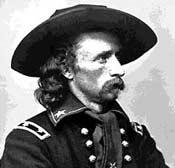(1839-1876)

George Armstrong Custer is one of the best-known figures in American history and in popular mythology long after his death at the hands of Lakota and Cheyenne warriors at the Battle of the Little Bighorn.
Custer was born in New Rumley, Ohio, but spent much of his childhood in Monroe, Michigan. After high school he enrolled in West Point where he proved to be a fairly miserable student. Several days after graduating last in his class, he failed in his duty as officer of the guard to stop a fight between two cadets. He was court martialed but saved from punishment only because of the need for officers upon the outbreak of the Civil War.
He fought in the First Battle of Bull Run, and served with distinction in the Virginia and Gettysburg campaigns. Although his units suffered enormously high casualty rates, his fearless aggression in battle earned him the respect of his commanding officers. His cavalry units played a critical role in forcing the retreat of Confederate General Robert E. Lee’s forces. In gratitude, General Philip Sheridan bought and made a gift of the Appomatox “surrender table” to Custer and his wife, Elizabeth Bacon Custer.
Custer was appointed lieutenant-colonel of the Seventh Cavalry in July 1866 . The next year he led the cavalry in a campaign against the Southern Cheyenne. Then, in late 1867 Custer was again court-martialed and suspended from duty for a year for being absent from duty during the campaign. Custer maintained that he was simply being made a scapegoat for a failed campaign, and his old friend General Phil Sheridan stepped in to help him by calling Custer back to duty in 1868. The army once again took a liking to Custer after his November 1868 attack on Black Kettle’s band on the banks of the Washita River.
in 1873, Custer was sent to the Northern Plains where he participated in a some small skirmishes against the Lakota in the Yellowstone area. The following year, he lead a 1,200 person expedition to the Black Hills, land which just six years earlier had been guaranteed to the Lakota.
In 1876, Custer was scheduled to lead part of an anti-Lakota expedition, along with Generals John Gibbon and George Crook. He almost didn’t make it. His testimony in March about Indian Service corruption so infuriated President Ulysses S. Grant that he relieved Custer of his command and replaced him with General Alfred Terry. Popular disgust, however, forced Grant to reverse his decision. Custer then went West.
The original government plan for defeating the Lakota called for the three forces under the command of Crook, Gibbon, and Custer to trap the majority of the Lakota and Cheyenne population between them and deal them a crushing defeat. Custer advanced more quickly than ordered to do, and neared what he thought was a large Indian village on the morning of June 25, 1876. He was unaware of two important facts: his rapid advance had put him far ahead of Gibbon’s infantry brigades and General Crook’s forces had been turned back by Crazy Horse’s band at Rosebud Creek.
Believing that he was on the verge of a certain victory for both the government and himself, Custer ordered an immediate attack on the Indian village. Badly miscalculating Indian military prowess, he split his forces into three parts to ensure that fewer Indians would escape. This attack turned out to be one the greatest fiascos of the United States Army. Thousands of Lakota, Cheyenne and Arapaho warriors forced Custer’s unit back onto a long dusty ridge parallel to the Little Bighorn where they surrounded and killed all 210 of Custer’s troops.
Custer’s blunders may have cost him his life but it gained him everlasting fame. The Little Bighorn defeat made the life of what would have been an obscure 19th century military figure into the subject of countless songs, books and paintings. His widow furthered his reputation by writing laudatory accounts of his life, portraying him as not only a military genius but also a refined and cultivated man, a patron of the arts, and a budding statesman.
Countless paintings of “Custer’s Last Stand” were made, including one distributed by the Anheuser-Busch brewing company. All of these paintings depicted Custer as a gallant victim, surrounded by bloodthirsty savages intent upon his annihilation. Forgotten were the facts that he had started the battle by attacking the Indian village, and that most Indians present were forced to surrender within a year of their greatest battlefield triumph.





